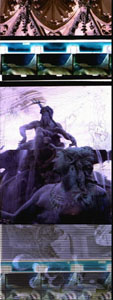

 In 2003 the influential American experimental filmmaker Stan Brakhage passed away. This stirred up Chun-hui Wu’s memories of viewing his classic work “Mothlight” (1960). Brakhage made this film without a camera, by piecing together a collage of flower petals and plants directly onto a length of transparent film, and thus creating bizarre images of fluttering moths. Wu’s “Incarnation (Boy)” is a work made in homage to Brakhage. From a film studio trash can, Wu scavenged film stock that someone else had thrown away, and then pasted dry flower petals on the film, forming a double fantasy of super-imposed images. The original, discarded images of a boy, reprocessed by the artist, are endowed with a new incarnation, like gazing anew at and reconsidering civilization at the beginning of the age of mechanical reproduction.
In 2003 the influential American experimental filmmaker Stan Brakhage passed away. This stirred up Chun-hui Wu’s memories of viewing his classic work “Mothlight” (1960). Brakhage made this film without a camera, by piecing together a collage of flower petals and plants directly onto a length of transparent film, and thus creating bizarre images of fluttering moths. Wu’s “Incarnation (Boy)” is a work made in homage to Brakhage. From a film studio trash can, Wu scavenged film stock that someone else had thrown away, and then pasted dry flower petals on the film, forming a double fantasy of super-imposed images. The original, discarded images of a boy, reprocessed by the artist, are endowed with a new incarnation, like gazing anew at and reconsidering civilization at the beginning of the age of mechanical reproduction.
Chun-hui Wu’s experimental film works are deft reutilizations of old, archived images, serving as channels for reconsidering the relationship between self and medium. For example, in 2000, his “Psycho Shower” reproduced the shower murder scene from the famous Alfred Hitchcock movie “Psycho” (1960) as a series of single-frame still photos, replicated and edited as sound film, and subverting the viewer’s expectations of the dramatic climax during the viewing experience. In these series of images pieced together as motion pictures, Wu repeatedly experiments with various meanings that extend from the tension between “motion” and “still” states. His newest work “Europe Resurrection” starts with still images, splicing together film taken in a variety of formats (35mm slides, 16mm, 8mm, super 8) and captured during many years of travel, and aligns them to the 24-frames-per-second temporal mode of motion pictures. The artist made archives of his foreign journeys, then working by hand, overlaid these archives with photos of his own private life growing up. Next, through digital control of frame lag time, he produced a dialogue between different times and places, sparking a range of disparate thoughts regarding his own identity and various lands. “Europe Resurrection” attempts to awaken the deep internal memories of both the artist and the viewer.